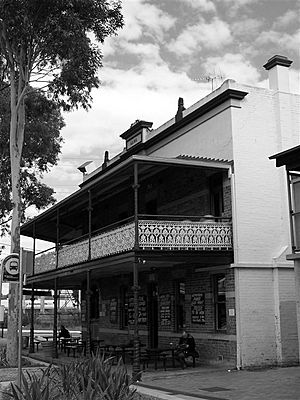Imperial Hotel, Rooty Hill facts for kids
Quick facts for kids Imperial Hotel |
|
|---|---|

Imperial Hotel, 2016
|
|
| Location | 1 Rooty Hill Road North, Rooty Hill, City of Blacktown, Sydney, New South Wales, Australia |
| Owner | Dyemist Pty Ltd |
| Official name: Imperial Hotel | |
| Type | state heritage (built) |
| Designated | 2 April 1999 |
| Reference no. | 114 |
| Type | Hotel |
| Category | Commercial |
| Lua error in Module:Location_map at line 420: attempt to index field 'wikibase' (a nil value). | |
The Imperial Hotel is a special building in Rooty Hill, Sydney, Australia. It is listed on the New South Wales State Heritage Register, which means it is an important historical place. The hotel was added to this list on April 2, 1999. It is located at 1 Rooty Hill Road North and is owned by Dyemist Pty Ltd.
Contents
History of the Imperial Hotel
Why the Hotel Was Built
The Imperial Hotel was built in 1890. It has two floors and was made to welcome many people. These visitors came by train to watch greyhound racing at Plumpton. F. J. Weston from Horsley Park built the hotel, and it first opened on August 12, 1890. At that time, Rooty Hill was part of the St. Mary's Parish. People knew the area as Rooty Hill by 1810.
Rooty Hill's Early Days
The Rooty Hill area has a long history. It was once used by the government for cattle. Many important landowners lived here. For example, Walter Lamb started a factory in 1884. This factory canned fruits and preserved them at his Woodstock estate in Plumpton.
The area was also known for growing grapes to make wine. This happened at Minchinbury, which was Dr. Charles Mackay's estate. The Great Western Railway line helped Rooty Hill grow. The train station made it easier to transport wine and canned goods.
A public school opened in 1875. The School of Arts, built in 1902, was where the Blacktown Council first met in 1906. Blacktown officially became a shire (a type of local government area) in 1906.
How the Hotel Changed Over Time
When the Imperial Hotel opened, Rooty Hill was a busy place. It had shops and homes, and the hotel added to its lively feel. The hotel did very well at first. Many people came to watch greyhound racing at Lamb's Woodstock Coursing Track.
However, the hotel's business later slowed down. In 1936, its license to sell beer was moved to Wallacia. After that, the hotel became a wine bar owned by Penfolds Wines. By the early 1970s, it was almost falling apart.
In 1977, a local dentist bought the hotel. It was boarded up at the time. The National Trust, a group that protects historical places, recognized the property in 1976. This led to plans to restore it. Building permits were approved in 1981-1982, and the hotel reopened in 1982.
Recent Changes and Features
Around 1995, a new single-story part was added to the hotel. This filled in an open area along North Parade. There is also a pepper tree in the beer garden that is about 40 to 50 years old. It seems there were other pepper trees on this site in the past.
The hotel's entrance was updated in 1987. In 1990, the rooms that used to be for guests were changed into office spaces. More restoration work and changes were done in 1995.
What the Imperial Hotel Looks Like
The Imperial Hotel is a two-story building made of brickwork and cement. It sits on a corner. It has a verandah on the first floor facing the street. This verandah has pretty cast iron lace railings and cast iron columns.
The hotel is right on the corner of the street. It has a beer garden to the southwest, next to North Avenue. There is also a car parking area to the north, facing Rooty Hill Road. Over the years, several parts have been added to the back of the building. This includes a single-story section that has been changed. Around 1995, another part was added that filled in the courtyard facing North Parade. This created a bistro (a type of restaurant) at the back.
In 2007, it was noted that many of the original parts inside the hotel were still there. These include the wooden staircase, several fireplaces, and different types of ceiling coverings. Some ceilings are plaster, some are wood, and some are pressed metal. There are also decorative plaster cornices and other details.
Why the Hotel is Important
The Imperial Hotel is important because it was built in 1890 for people coming to greyhound races. It is a significant building that stands out. It also served as a social gathering place for the community.
The Imperial Hotel was officially listed on the New South Wales State Heritage Register on April 2, 1999. This means it is protected as a valuable part of history.


